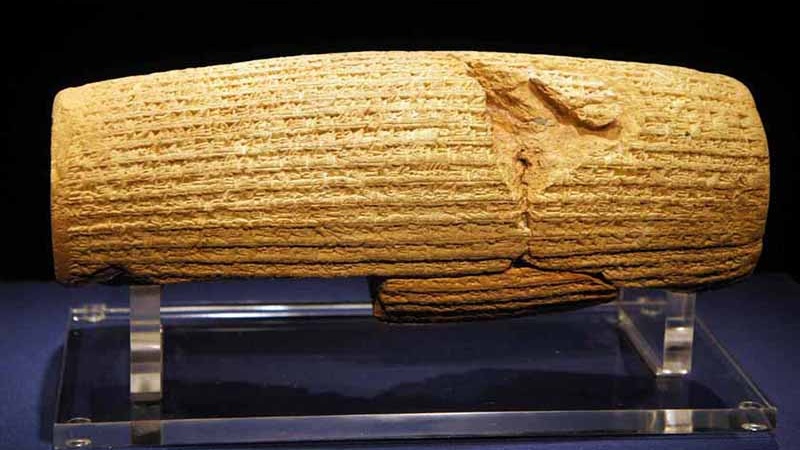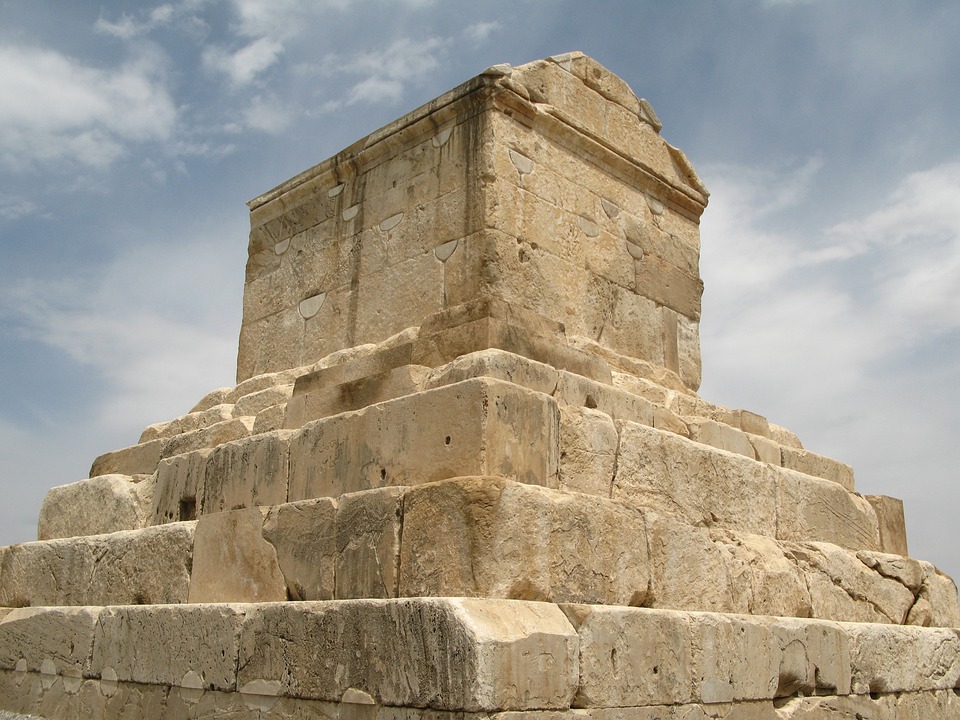| Le cylindre de Cyrus, conservé au British Museum | |
| Type | Cylindre d’argile |
|---|---|
| Dimensions | 22,5 × 10 cm (maximum)1 |
| Méthode de fabrication | Écriture cunéiforme akkadienne |
| Fonction | Inscription de fondation |
| Période | Environ 539–530 av. J.-C. |
| Culture | Empire perse achéménide1 |
| Date de découverte | Mars 18791 |
| Lieu de découverte | Babylone, Mésopotamie par Hormuzd Rassam1 |
| Conservation | British Museum, Londres2 |
| Fiche descriptive | Cyrus cylinder [archive] |
First Charter of Human Rights
Cyrus Charter of Human Rights Cylinder
Charter of the Rights of Nations Inscribed on a clay cylinder in cuneiform discovered in 1879 now in The British Museum, London.

HISTOIRE
Cylindre de Cyrus
Il a été découvert à Babylone en 1879 par Hormuzd Rassam et est depuis exposé au British Museum de Londres.
Ce document est couramment mentionné comme étant « la première charte des droits de l'homme ». En 1971, l'ONU l'a traduit dans toutes ses langues officielles.

DÉCOUVERTE
Hormuzd Rassam à Mossoul, circa, 1854.
Le cylindre de Cyrus a été découvert par Hormuzd Rassam lors de ses fouilles à Babylone en février-mars 1879.
L'archéologue assyro-britannique Hormuzd Rassam découvre le cylindre de Cyrus en mars 1879 lors d'un long programme de fouilles en Mésopotamie réalisé pour le British Museum. Le cylindre avait la fonction d'« inscription de fondation » au sein des fondations de l'Esagil, le temple principal de la ville, dédié au dieu Marduk.
CYRUS PROCLAME
LA LIBERTÉ DE CULTE
DANS TOUT L’EMPIRE PERSE
CYLINDRE DE CYRUS
PERSE
539
© Musée International de la Croix-Rouge, Genève
LE CYLINDRE DE CYRUS, 1er EMPEREUR DE PERSE
« Je suis Cyrus, roi du monde, grand roi, puissant roi, roi de Babylone, roi de Sumer et d'Akkad, roi des quatre quarts, le fils de Cambyse, grand roi, roi d'Anšan, petit-fils de Cyrus, grand roi, roi d'Anšan, descendant de Teispès, grand roi, roi d'Anšan, d'une lignée royale éternelle, dont Bēl et Nabû aiment la royauté, dont ils désirent le gouvernement pour le plaisir de leur cœur.
Quand je suis entré à Babylone d'une manière pacifique, j'établis ma demeure seigneuriale dans le palais royal au sein des réjouissances et du bonheur. Marduk, le grand seigneur, fixa comme son destin pour moi un cœur magnanime d'un être aimant Babylone, et je m'emploie à sa dévotion au quotidien. Ma vaste armée marcha sur Babylone en paix ; je ne permis à personne d'effrayer les peuples de Sumer et d'Akkad. J'ai recherché le bien-être de la ville de Babylone et de tous ses centres sacrés. Pour ce qui est des citoyens de Babylone, auxquels Nabonide avait imposé une corvée n'étant pas le souhait des dieux et ne [...] convenant guère [aux citoyens], je soulageai leur lassitude et les libérai de leur service.
Marduk, le grand seigneur, se réjouit de mes bonnes actions. Il donna sa gracieuse bénédiction à moi, Cyrus, le roi qui le vénère, et à Cambyse, le fils qui est ma progéniture, et à toute mon armée, et en paix, devant lui, nous nous déplaçâmes en amitié. Par sa parole exaltée, tous les rois qui siègent sur des trônes à travers le monde, de la mer Supérieure à la mer Inférieure, qui vivent en des districts fort éloignés, les rois de l'Ouest, qui résident en des tentes, tous, apportèrent leur lourd tribut devant moi et à Babylone embrassèrent mes pieds.
De Babylone à Assur et de Suze, Agade, Eshnunna, Zamban, Me-Turnu, Der, d'aussi loin que la région de Gutium, les centres sacrés de l'autre côté du Tigre, dont les sanctuaires avaient été abandonnés pendant longtemps, je retournai les images des dieux, qui avaient résidé [à Babylone], à leur place et je les laissai résider en leurs demeures éternelles. Je rassemblai tous leurs habitants et leur redonnai leurs résidences. En plus, sur commande de Marduk, le grand seigneur, j'installai en leurs habitats, en d'agréables demeures, les dieux de Sumer et Akkad, que Nabonide, provoquant la colère du seigneur des dieux, avait apportés à Babylone. Puissent tous les dieux que j'installai dans leurs centres sacrés demander quotidiennement à Bel et Nabû que mes jours soient longs, et puissent-ils intercéder pour mon bien-être. [...] Le peuple de Babylone bénit mon règne, et j'établis toutes les terres en de pacifiques demeures. » (Réf. : https://fr.wikipedia.org/wiki/Cylindre_de_Cyrus)
CYRUS CYLINDER
The charter of Cyrus the Great, a baked-clay Aryan language (Old Persian) cuneiform cylinder, was discovered in 1878 in excavation of the site of Babylon. In it, Cyrus the Great described his human treatment of the inhabitants of Babylonia after its conquest by the Iranians. The document has been hailed as the first charter of human rights, and in 1971 the United Nations was published translation of it in all the official U.N. languages. "May Ahura Mazda protect this land, this nation, from rancor, from foes, from falsehood, and from drought".
« I am Cyrus, king of the universe, the great king, the powerful king, king of Babylon, king of Sumer and Akkad, king of the four quarters of the world, son of Cambyses, the great king, king of the city of Anshan, grandson of Cyrus, the great king, ki[ng of the ci]ty of Anshan, descendant of Teispes, the great king, king of the city of Anshan, the perpetual seed of kingship, whose reign Bel (Marduk)and Nabu love, and with whose kingship, to their joy, they concern themselves.
When I went as harbinger of peace i[nt]o Babylon I founded my sovereign residence within the palace amid celebration and rejoicing. Marduk, the great lord, bestowed on me as my destiny the great magnanimity of one who loves Babylon, and I every day sought him out in awe. My vast troops were marching peaceably in Babylon, and the whole of [Sumer] and Akkad had nothing to fear. I sought the safety of the city of Babylon and all its sanctuaries. As for the population of Babylon […, w]ho as if without div[ine intention] had endured a yoke not decreed for them, I soothed their weariness; I freed them from their bonds(?).
Marduk, the great lord, rejoiced at [my good] deeds, and he pronounced a sweet blessing over me, Cyrus, the king who fears him, and over Cambyses, the son [my] issue, [and over] my all my troops, that we might live happily in his presence, in well-being. At his exalted command, all kings who sit on thrones, from every quarter, from the Upper Sea to the Lower Sea, those who inhabit [remote distric]ts (and) the kings of the land of Amurru who live in tents, all of them, brought their weighty tribute into Shuanna, and kissed my feet.
From [Shuanna] I sent back to their places to the city of Ashur and Susa, Akkad, the land of Eshnunna, the city of Zamban, the city of Meturnu, Der, as far as the border of the land of Guti - the sanctuaries across the river Tigris - whose shrines had earlier become dilapidated, the gods who lived therein, and made permanent sanctuaries for them. I collected together all of their people and returned them to their settlements, and the gods of the land of Sumer and Akkad which Nabonidus – to the fury of the lord of the gods – had brought into Shuanna, at the command of Marduk, the great lord, I returned them unharmed to their cells, in the sanctuaries that make them happy. May all the gods that I returned to their sanctuaries, every day before Bel and Nabu, ask for a long life for me, and mention my good deeds, and say to Marduk, my lord, this: “Cyrus, the king who fears you, and Cambyses his son, may they be the provisioners of our shrines until distant (?) days, and the population of Babylon call blessings on my kingship. I have enabled all the lands to live in peace.”
CYRUS DECLARES
FREEDOM OF RELIGION
THROUGHOUT THE PERSIAN EMPIRE
CYRUS CYLINDER
PERSIA
539
© Musée International de la Croix-Rouge, Genève

TOMBEAU DE CYRUS
Near Shiraz
After victory over Bavylonia, Cyrus The Great presented himself not as a conqueror, but a liberator and the legitimate successor to the crown. He took the title of « King o f Babylon and King of the Land ». Cyrus had no thought of forcing conquered people into a single mould, and had the wisdom to leave unchanged the institution of each kingdom he attached tot he Persian Crown. In 537 BC he allowed more than 40,000 Jews to leave Babylon and returne to Palestine.
Article paru dans le magazine GEO Histoire spécial Iran (n°35).
Cyrus, Darius, Xerxès : trois rois pour une Perse rayonnante

Neil MacGregor
Historien de l’art et administrateur culturel
Né le 16 juin 1946 à Glasgow (Écosse), il a été rédacteur en chef du Burlington Magazine de 1981 à 1987, directeur de la National Gallery à Londres de 1987 à 2002 puis directeur du British Museum à partir de 2002.
Neil MacGregor est né à Glasgow de deux médecins, Alexander et Anna MacGregor. Il est élève à la Glasgow Academy puis les langues vivantes à New College (Oxford), dont il est désormais honorary fellow. Il étudie ensuite la philosophie à l'École normale supérieure, à Paris (durant Mai 68), et le droit à l'université d'Édimbourg, où il reçoit le Green Prize. Devenu avocat en 1972, MacGregor décide d'étudier l'histoire de l'art à la summer school de l'Institut Courtauld en Bavière : son directeur Anthony Blunt le persuade de poursuivre ses études avec lui. Blunt considère MacGregor comme « son plus brillant élève ».
Ispahan, joyau de la Perse musulmane
Ispahan, une simple bourgade devenue un joyau de la Perse musulmane
© GEO
J’IMAGINE
La révolte prêchée par quelque douce femme
Deux mille ans de prison dévorés par les flammes
J’imagine
L’amour faisant l’amour la vie faisant le reste
Une révolution sans un mot sans un geste
Et la grande liberté
Au poing la rose
Et la grande liberté
La rose au poing
Et la grande liberté
La rose au poing
J’imagine
Un peuple dynamite et pourtant sans défense
Tout en lui ne serait qu’amour et transparence
J’imagine
Un hiver tout de neige et fleurissant quand même
Pour des femmes-chansons pour des hommes-poèmes
Et la grande liberté
Au poing la rose
Et la grande liberté
La rose au poing
Et la grande liberté
La rose au poing
J’imagine
L’Occident sans ghettos le Brésil sans torture
Et l’Afrique riant comme source d’eau pure
J’imagine
Le soleil se levant sur l’Asie douce et libre
La vie enfin la vie comme il faudra la vivre
Et la grande liberté
Au poing la rose
Et la grande liberté
La rose au poing
Et la grande liberté
La rose au poing

